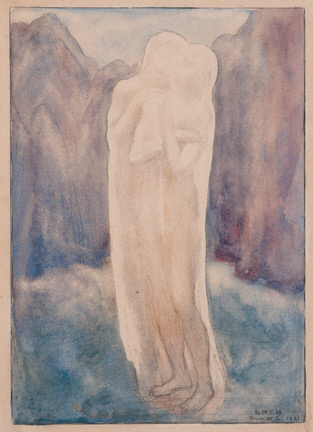This is another post taken from my independent study research. Hoping to get back to my typical posting style soon! Meanwhile, Autism and Spirituality © 2025 by Kimberly Israel is licensed under CC BY-NC 4.0
Bertelli et al.: Benefits of spirituality for intellectually disabled and high-support autistic populations
Bertelli et al. (2020) begin their work by noting that,
although the importance of spirituality to well-being has become more generally
recognized in the past 20 years, research on the topic with respect to
intellectually disabled and “low-functioning autistic[1]”
(ID/LFA) populations. Their literature review on the topic provides a broad
view of what the relatively small number of studies have found. Measures of
spirituality vary, but the World Health Organization Quality of Life –
Spirituality, Religion, and Personal Beliefs instrument (WHO, 2012) is a
representative example. It considers spirituality in terms of connection to a
spiritual entity, meaning, joy, inner strength, peace, hope, and faith.
The results of the literature review are unsurprising in
light of the conventional wisdom on the importance of spirituality to the
“mainstream” population. Spirituality is positively correlated with religious
participation extraversion, adaptability, understanding, goal setting,
motivation, confidence, cognition, emotional connection, self-control,
resilience, immune function, endocrine function, and life expectancy. It is
negatively correlated with physical symptoms, heart disease, risk of
psychopathology and suicide, anxiety, loneliness, individualism, and
“manifestations of unconditional personal freedom” (Bertelli et al., 2020).
The major benefits for ID/LFA populations appear to be life
interest and satisfaction; opportunities for growth; frameworks for
understanding life, death, and complex emotions; and a lower risk of anxiety,
depression, and destructive behaviors such as substance abuse and suicide. Bertelli
et al. note, however, that religion has its own risks. Obsessions, delusions,
and hallucinations frequently include religious material. For some, religion
can intensity neurosis and feelings of fear or guilt; constricting religious
beliefs may result in avoidance of life changes and a narrowing of agency in
life. Furthermore, ID/LFA individuals may experience rejection by members of
religious organizations. In order to
best meet the needs of the ID/LFA population, more attention to spiritual
well-being is required from service providers and more structural and social
accommodations must be established by religious organizations (Bertelli et al.,
2020).
Crespi et al.: Autism, schizophrenia, and spirituality
Crespi et al. (2019) report that autistic and schizotypal
psychological traits are both inversely correlated with participation in organized religion but that
the reasons may differ between the two psychological categories. In a broad
sense, they suggest autistic people simply lack religious belief, while
schizophrenic people have beliefs that are too idiosyncratic to fit into an
organized religion. They also note that organized religion is a relatively
recent development when considered within the timespan of human evolution.
Furthermore, they suggest that the implied separation between natural and
supernatural is similarly recent, as indigenous societies have typically
modeled the entire world as both natural and spiritual.[2]
To explain the roots of human religiosity, Crespi et al. cite Lindeman et al.
(2015), who found in a study of Finnish adults that supernatural and religious
beliefs are best predicted by “core
ontological confusions” between the properties of physical and mental, animate and
inanimate, and living and nonliving objects. Importantly, Lindeman et al. also
found that mentalizing ability per se did not predict supernatural and
religious belief, suggesting that lower mentalizing ability does not explain
any difference in religious participation between autistic and neurotypical
populations.
[1]
Autistic functioning labels used by researchers are introduced in quotes
because many in the autism community find them objectionable (Vance, 2018).
[2]
The fact that many indigenous societies also have traditions that specifically
function to interface between the “everyday” world and the “spirit” world
suggests that this may be an oversimplification.
https://commons.wikimedia.org/wiki/File:Spirit_of_Light_or_Spiritual_Communion_by_Kahlil_Gibran.jpg
References
Bertelli, M.O., Del Furia, C., Bonadiman, M., Rondini, E.,
Banks, R., & Lassi, S. (2020). The relationship between spiritual life and
quality of life in people with intellectual disability and/or low-functioning
autism spectrum disorders. Journal of Religion and Health, 59(4),
1996-2018.
Crespi, B., Dinsdale, N., Read, S., & Hurd, P. (2019).
Spirituality, dimensional autism, and schizotypal traits: the search for
meaning. PLoS ONE, 14(3), e0213456.
Lindeman, M.,
Svedholm-Hakkinen, A.M., & Lipsanen, J. (2015). Ontological
confusions but not mentalizing abilities predict religious belief, paranormal
belief, and belief in supernatural purpose. Cognition, 134, 63-76.
Vance, T. (2018, September 10). Function labels: and
we're supposed to be the awkward ones... NeuroClastic. https://neuroclastic.com/the-journey-begins/.
WHO. (2012). WHOQOL-SRPB field-test instrument
(WHO/MSD/MER/Rev.2012.04). World Health Organization, Department of Mental
Health & Substance Dependence. https://www.who.int/publications/i/item/WHO-MSD-MER-Rev-2012-04.



No comments:
Post a Comment
Please be nice.